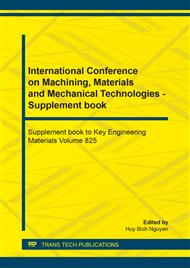[1]
Frising, T., Noik, C., and Dalmazzone, C., The Liquid/Liquid Sedimentation Process: From Droplet Coalescence Technologically Enhanced Water/Oil Emulsion Gravity Separators: A Review, J. Dispersion Sci. Technol. 27(7), (2006) p.1035–1057.
DOI: 10.1080/01932690600767098
Google Scholar
[2]
J. C. Berrio et al, Computational Fluid Dynamics Modeling of Gas–Liquid Cylindrical Cyclones, Geometrical Analysis, Journal of Energy Resources Technology, Copyright VC 2018 by ASME September 2018, Vol. 140.
DOI: 10.1115/1.4039609
Google Scholar
[3]
Kouba, G. E. A., and O. Shoham, Review of gas-liquid cylindrical cyclone technology, International Conference of Production Separation Systems, Aberdeen, UK (1996).
Google Scholar
[4]
Shoham, O., Kouba, G.E, State of the art of gas/liquid cylindrical-cyclonecompact-separator technology, SPE, Vol 2-5, (1998) pp.462-471.
Google Scholar
[5]
Arpandi, I. et al, Hydrodynamics of Two-Phase Flow in Gas/Liquid Cylindrical-Cyclone Separators, SPE Journal (1996) 427.
DOI: 10.2118/30683-pa
Google Scholar
[6]
Gomez, L. E., R. S. Mohan, O. Shoham, J. D. Marrelli, and G. E. Kouba, State-of-the-art simulator for field applications of gas-liquid cylindrical cyclone separators, SPE Annual Technical Conference and Exhibition, Houston, Texas (1999).
DOI: 10.2118/56581-ms
Google Scholar
[7]
Erdal, F., and S. Shirazi, Local velocity measurements and computational fluid dynamics (CFD) simulations of swirling flow in a gas–liquid cylindrical cyclone separator, Engineering Technology Conference on Energy, Texas, (2001) 15, p.23–30.
DOI: 10.1115/etce2001-17101
Google Scholar
[8]
Mohan, R. 2013. Internal report. TUSTP.
Google Scholar
[9]
Hreiz, R., Gentric, C., Midoux, N., Numerical investigation of swirling flow in cylindrical cyclones, Chem. Eng. Res. Des. 89, (2011) p.2521–2539.
DOI: 10.1016/j.cherd.2011.05.001
Google Scholar
[10]
Lê Văn Sỹ, Nghiên cứu động lực học dòng chảy trong bộ tách lọc dầu/khí glcc, Tuyển tập công trình hội nghị khoa học cơ học thủy khí toàn quốc năm (2015).
DOI: 10.15625/vap.2019000306
Google Scholar
[11]
Le Van Sy, 2016, Influence of inlet angle on flow pattern and performance of gas-liquid cylindrical cyclone separator, Particulate Science And Technology http://dx.doi.org/10.1080/02726351.2016.1180336.
DOI: 10.1080/02726351.2016.1180336
Google Scholar
[12]
S. Kolla, S. Mohan and O. Shoham, Experimental Investigation of Liquid Carry-Over in GLCC Separators for 3-Phase Flow, Paper No. IMECE2016-67457, pp. V007T09A006; 10 pages.
DOI: 10.1115/imece2016-67457
Google Scholar
[13]
S. Movafaghian et al, The effects of geometry, fluid properties and pressure on the hydrodynamics of gas-liquid cylindrical cyclone separators, International Journal of Multiphase Flow 26 (2000) 999-1018.
DOI: 10.1016/s0301-9322(99)00076-2
Google Scholar
[14]
Erdal, F., Shirazi, S, Effect of inlet configuration on flow behavior in a cylindrical cyclone separator, In: ASME Eng. Technol. Conf. on Energy (2002).
DOI: 10.1115/etce2002/manu-29110
Google Scholar
[15]
Hreiz, R. et al., 2014, Hydrodynamics and velocity measurements in gas–liquid swirling flows in cylindrical cyclones, Chemical engineering research and design. http://dx.doi.org/10.1016/j.cherd.2014.02.029.
DOI: 10.1016/j.cherd.2014.02.029
Google Scholar
[16]
Hreiz, R. et al., On the effect of the nozzle design on theperformances of gas–liquid cylindrical cyclone separators," Int.J. Multiphase Flow 58, (2014) p.15–26.
DOI: 10.1016/j.ijmultiphaseflow.2013.08.006
Google Scholar
[17]
Ho Minh Kha, Nguyen Ngoc Phuong and Nguyen Thanh Nam, The effect of different geometrical configurations of the performances of Gas-Liquid Cylindrical Cyclone separators (GLCC), System Science and Engineering (ICSSE), 2017 International Conference on.
DOI: 10.1109/icsse.2017.8030955
Google Scholar
[18]
S. Kolla et al, Structural integrity analysis of gas-liquid cylindrical cyclone (GLCC) separator inlet, Journal of Energy Resources Technology - May 2018, Vol. 140.
DOI: 10.1115/1.4038622
Google Scholar
[19]
http://www.thermopedia.com/content/8/. Kataoka, Isao, Serizawa, Akimi.
Google Scholar
[20]
http://www.thermopedia.com/content/11/. Zeigarnik, Yuri Albertovich.
Google Scholar
[21]
http://www.thermopedia.com/content/264/. Jayanti, Sreenivas.
Google Scholar
[22]
Ho Minh Kha, Nguyen Thanh Nam, Hoang Duc Lien, Vo Tuyen, Svetlin Antonov, Ivan Antonov, A research on the kinematics and the performances of the effect of the geometrical shape of inlet nozzles of Gas–Liquid Cylindrical Cyclone (GLCC) separators, XXIII Scientific Conference with International Participation (FPEPM 2018), pp.186-198.
DOI: 10.1109/icsse.2017.8030955
Google Scholar
[23]
Ho Minh Kha, Nguyen Thanh Nam, Vo Tuyen, Nguyen Tan Ken, Experimental study of square inlets effect on the performances of gas–liquid cylindrical cyclone separators (glcc), International Conference on Machining, Materials and Mechanical Technologies (IC3MT 2018), Ho Chi Minh City, Vietnam, pp.230-236.
DOI: 10.1109/icsse.2017.8030955
Google Scholar


